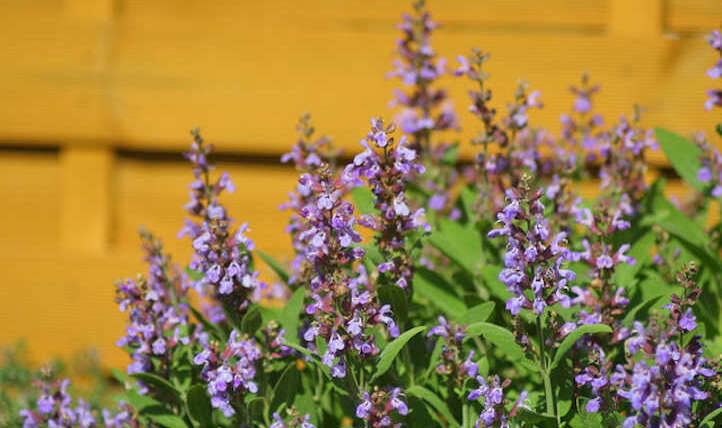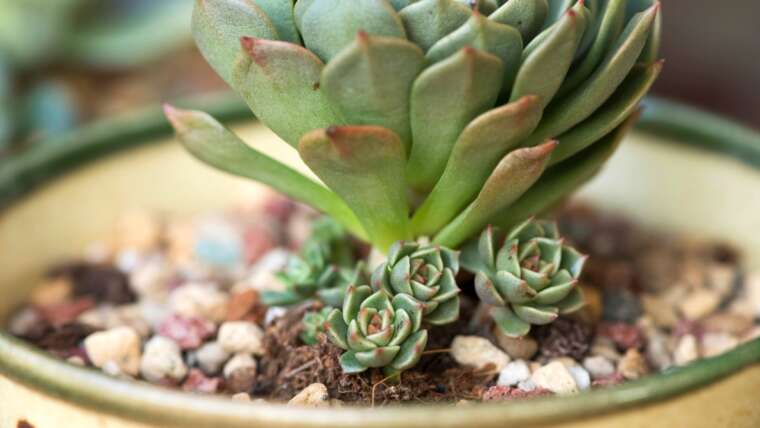After record-setting temperatures blazed across the country, lawn alternatives have taken the internet by storm. Many TikTokers have chronicled the banishment of regular lawns and shift to clover carpets. Many scientists agree that conventional lawns are not environmentally sustainable. They require significant amounts of water, fertilizer, herbicides, and maintenance. But you can still have a beautiful yard with a lawn replacement like microclover.
This attractive miniature clover is eco-friendly, low-maintenance, and practically cares for itself. It fixes its own nitrogen and tolerates drought with ease. Better yet, it’s naturally competitive against weeds and doesn’t require much mowing. However, microclover does have a winter dormancy in northern zones and may not work for certain soils.
Let’s dig into why microclover is the perfect lawn replacement option for most environmentally-conscious landscapes (and which gardens should avoid or mix it).
The Short Answer: Microclover is a Low-Maintenance, Drought-Tolerant Lawn Replacement
If you want to replace your thirsty, nutrient-hungry, high-maintenance grass lawn, microclover is the perfect eco-friendly alternative. This leguminous plant works with symbiotic bacteria to fix nitrogen, which means you don’t have to add any fertilizer. The seeds are affordable and widely available, and maintenance is easy to integrate into existing routines.
Microclover does not require frequent watering or mowing yet remains nicely green year-round in zones six and warmer. The small clover leaves add a lush, delicate appearance to your lawn and don’t stain or become patchy from dog waste like traditional lawns often do. This tiny groundcover plant spreads densely and evenly, creating a soft carpet for a lush, walkable lawn.
The Long Answer
Add charm and reap ecological benefits to any landscape by switching from a traditional to a microclover lawn.
The rise of lawn alternatives began in the early 2000s and has since accelerated to mainstream popularity. With increasingly hot summers and long droughts in many regions, regular old grass doesn’t cut it. This miniature white clover has become increasingly popular for residential landscapes, parks, and public spaces thanks to its low maintenance attitude.
While it makes a great lawn alternative for some regions, it may not be ideal for northern climates or people with sandy soil. Here’s a deeper exploration of the pros and cons of replacing your yard with microclover.
What is Microclover?
 Microclover is low-growing and eco-friendly.
Microclover is low-growing and eco-friendly.
Microclover (Trifolium repens var. ‘Pirouette’ and ‘Pipolina’) is a tiny-leaf version of white clover, Trifolium repens. The variety was initially developed in the early 2000s as a lawn replacement. It is more drought-tolerant and low-maintenance than turf grass, requiring no fertilizer and far less mowing. The miniature clover leaves create an aesthetically pleasing lush carpet of greenery that remains evergreen year-round in warmer zones.
When compared to regular white clover, microclover is prized for its extra low growth, fewer flowers, and less aggressive nature. But like its parent, this is a perennial plant that is a member of the legume family. It works with symbiotic bacteria to fix its own nitrogen, which means no fertilizer is needed to fuel this vigorous plant as it covers your lawn and chokes out weeds.
Benefits of a Microclover Lawn Replacement (Pros)
 The benefits of microclover as a lawn replacement make it an attractive choice for homeowners and landscape designers.
The benefits of microclover as a lawn replacement make it an attractive choice for homeowners and landscape designers.
Whether you sow a 100% clover lawn or mix it with turfgrass, researchers have found that microclover significantly reduces or eliminates the need for nitrogen fertilizer. This discovery alone is a major win, considering that lawn nutrient runoff contributes to major pollution of waterways in urban areas.
Better yet, microclover is scientifically proven to require less mowing and less irrigation than grass. Here are more awesome benefits of replacing part or all of your lawn with these lucky little three (and occasionally four!) leaved clovers.
Thanks to its deep root system, microclover has impressive drought tolerance and endures dry summers far better than most grass species. It stays green without irrigation, even during the most scarce periods of rain. If your region has water restrictions in the summer (hello, Texas and California!), this lawn replacement will fare much better than grass.
A clover lawn replacement can be much cheaper than turf species. The seeds are very affordable, and your fertilizer and chemical costs may be reduced to $0.
You don’t need to fertilize microclover at all! As a legume, this groundcover has a symbiotic relationship with root-dwelling bacteria called Rhizobium. The bacteria form nodules in the roots and work to transform atmospheric nitrogen into plant-available nitrogen. The plant creates its own fertilizer, so you don’t have to add expensive nitrates to the soil.
Many common lawn diseases and pests require chemical applications to keep lawns green. Microclover is naturally resistant to these attackers, requiring little to no pesticides or fungicides.
Compared to a traditional grass lawn, this alternative requires little upkeep or mowing. The small leaves remain uniform and carpet-like throughout the season. You can mow as little as once monthly and enjoy a nice lawn.
These tiny little clovers feel lovely to walk on and offer a comfortable texture under bare feet. You can still relax on your lawn, picnic, or sunbathe without prickly grass or weeds poking your skin. Many people compare it to walking on soft moss.
Microclover is easy to incorporate into your existing lawn care practice and doesn’t require any major changes in mowing or equipment. It tolerates lower mowing heights than other lawn alternatives like creeping thyme. You also don’t need to mow it as often as grass.
This is one of the best possible lawn species for dog owners! Unlike grass, microclover can withstand dog urine and poop without staining the leaves or creating dead patches. The clover practically absorbs the waste and won’t turn yellow like a standard lawn.
Clovers are versatile about light requirements and grow anywhere grass does. The only thing they can’t handle is full shade, which might be better for a lawn alternative like moss or dwarf mondo grass.
This plant is remarkably cold-hardy. It is perennial in USDA zones 3-12, but it typically remains evergreen in zones six and warmer. It may go dormant (turn brown) in colder zones but reliably returns to its lush green in the spring.
Overall, a microclover lawn is considered far more sustainable and environmentally conscious than conventional turfgrass because it uses far less water and doesn’t need chemical inputs.
What is the Downside? (Cons)
 Microclover as a lawn alternative may not be suitable for all households.
Microclover as a lawn alternative may not be suitable for all households.
Research on microclover in Europe has proven that this lawn replacement has benefits worldwide. But does it hold up to American lawn standards? A few drawbacks of this leguminous plant include lower tolerance for walking, different aesthetics, and winter dormancy in northern zones.
While it can withstand light foot traffic, this plant is not suitable for areas that receive heavy traffic. The wear and tear of sports fields or play areas can hinder microclover growth and turn into a muddy mess during rainy weather. If your lawn is heavily trafficked, consider mixing microclover with Kentucky bluegrass or using walkway pavers.
In colder climates, clover goes dormant in the winter and loses its pretty green appearance. Your lawn may not be as aesthetic during the colder months, but it won’t matter if you get a lot of snow. The plant is still reliably cold hardy and returns with lush growth every spring.
This plant is best adapted to well-drained soil and tolerates high clay conditions but does not do well in ultra-sandy soil. You may need to amend with compost, leaf mulch, or peat moss to improve sandy or poor soils.
Many homeowners are used to spraying their lawn weeds with broadleaf herbicides because grasses naturally resist the chemicals. However, microclover is a broadleaf plant that will die from herbicide application. Fortunately, it competes with weeds very well once established.
To maintain a dense lawn of microclover, you may need to reseed every 2-3 years. The plants lose vigor over time and pay become patchy if you don’t regularly reseed. If you want something that reseeds on its own, consider a creeping thyme lawn alternative.
Transitioning from traditional grass takes a bit of labor upfront. The soil preparation and seeding or planting microclover is a little more time-intensive than regular grass sod, but you only have to do it once!
If you’re used to a grassy lawn, clover can take some adjustment. The leaves are very pretty and deep green, but they don’t necessarily create the same lawn appearance as turf. If you want the most manicured microclover lawn possible, mow it short every 1-2 weeks.
While alternative lawns are far easier to care for than regular grass, they are not entirely maintenance-free. You must still mow, weed, and overseed your microclover to keep the lawn dense and lush. Consistent moisture is needed for establishment.
Microclover Lawns By Region
The general consensus amongst lawn experts is that you can grow a pure clover lawn in the south, but a mixed lawn is better in the north. Due to the dormancy cycles of clover, people who prefer a fully green lawn in the colder months should opt for a blend of microclover and grass.
Southern Lawns Can Plant Full Microclover Yards
 Thriving under the sun, microclover yards are a hit for southern states.
Thriving under the sun, microclover yards are a hit for southern states.
A pure clover lawn is an amazing option for homeowners in Texas, Florida, and southern California. The warm and mild climate of the south allows this lawn alternative to flourish year-round.
It remains lush green with very little irrigation and tolerates summer droughts. However, if your soil is extremely poor, you may need a native clover variety specifically adapted to your region.
Northern Lawns Should Mix Microclover With Grass
 Microclover mixed half and half with evergreen grass makes a winning blend for lawns in northern climates.
Microclover mixed half and half with evergreen grass makes a winning blend for lawns in northern climates.
If you’re not quite ready for a full-on clover wonderland, consider a 50/50 lawn mix. When switching to a microclover lawn replacement, the biggest concern for northern homeowners is the clover’s dormant period.
While the plant is perennial, it turns brown and dies back to the ground when temperatures fall below 25°F. If you don’t have snow cover, this can create an unsightly lawn for several months of the year. Even though the plant grows back in the spring, many homeowners don’t want a dead-looking yard.
A 50/50 mix of microclover and an evergreen grass seed (like Kentucky bluegrass) allows you to reap many clover benefits without enduring brown patches. The grass will enjoy the boost of nitrogen-fixing clover, yet it can take over with verdant green growth while the clover is dormant. Both plants return to their full glory in the spring, and your lawn is still more eco-friendly than grass alone.
Final Thoughts
Ultimately, microclover is very popular amongst millennial and Gen Z homeowners because it is better for the environment and potentially healthier for your family and garden. One of the best benefits of this lawn replacement is that it doesn’t require all the chemicals of a grass lawn.
You can forego watering during drought-stricken summers and don’t have to mow very often. If you are willing to put in a day of work to establish the lawn and potentially endure some brown patches during the winter, clover is the perfect trendy yard plant for you!




